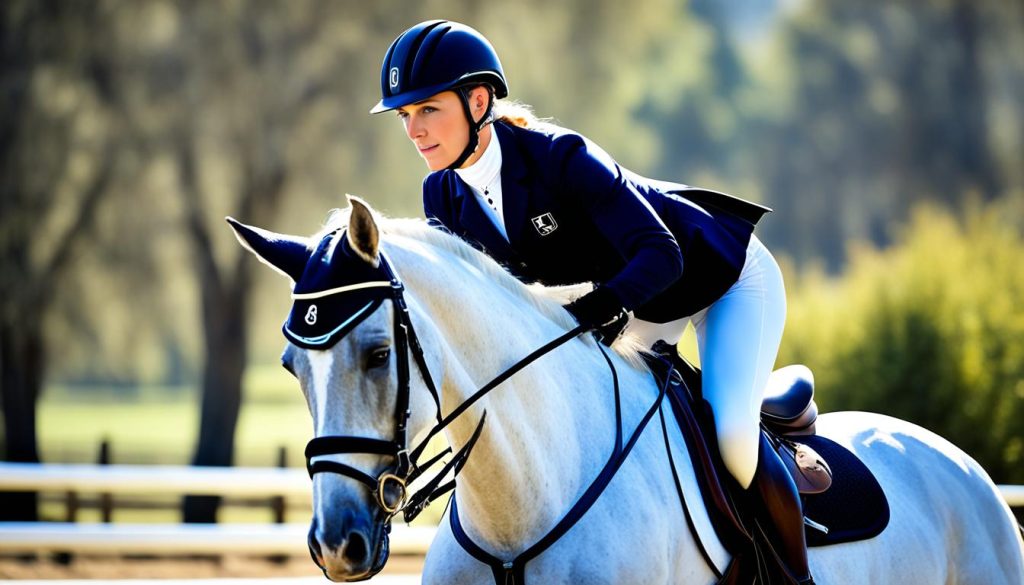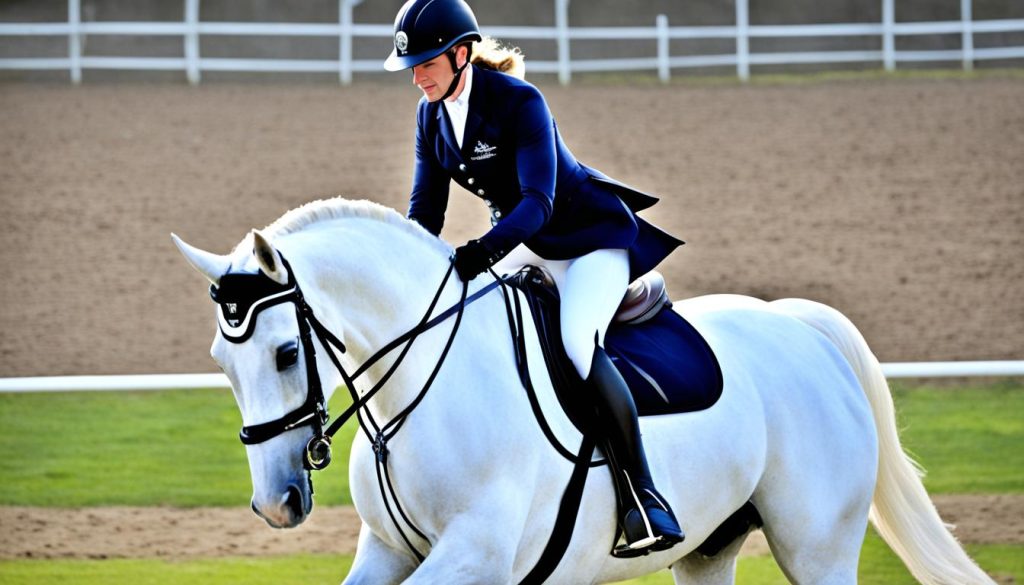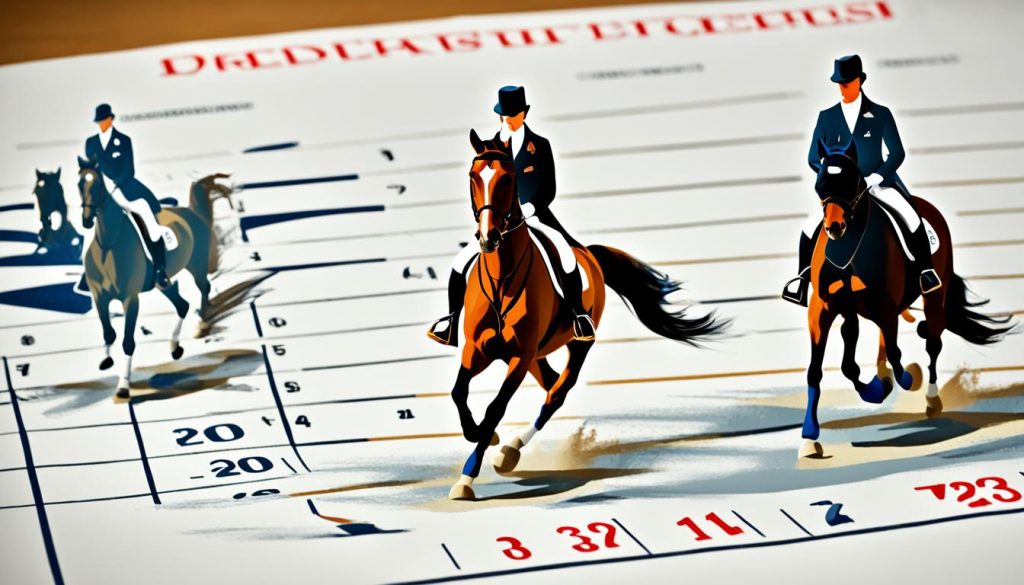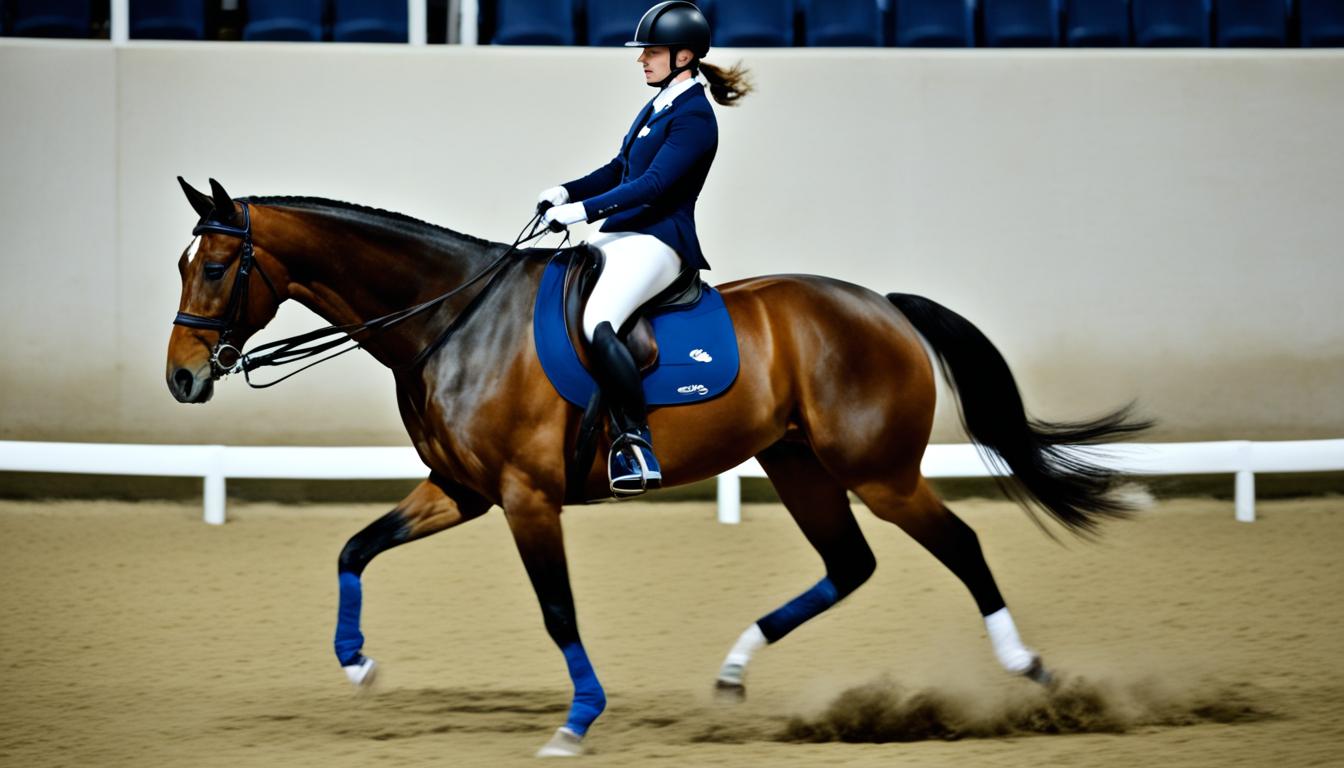Did you know that dressage, the elegant equestrian discipline, has been part of the Olympic Games since 1912? With its rich history and global popularity, dressage showcases the remarkable partnership between horse and rider. Whether you are a beginner or an experienced rider, mastering the basics of dressage techniques and riding fundamentals is essential for success in this intricate sport.
In this article, we will explore the key elements of dressage training, including its origins, the training process, key movements, competition levels, scoring criteria, and more. You will discover the importance of a balanced seat, effective aids, and clear communication in creating harmony with your horse. Let’s dive into the world of dressage and unlock the secrets to becoming a skilled dressage rider!
Key Takeaways:
- Mastering the basics of dressage training is crucial for success in this elegant equestrian discipline.
- Dressage has been an Olympic sport since 1912, highlighting its global appeal and rich history.
- A balanced seat, effective aids, and clear communication are essential for creating a harmonious partnership with your horse.
- Understanding the origins, movements, levels of competition, and scoring criteria will enhance your performance in dressage.
- Continued education through books and other resources can help you refine your dressage skills and knowledge.
Understanding Dressage and its Origins
Dressage is an equestrian discipline that has its roots in the French word “dresseur,” meaning to train. Over the years, it has evolved into an elite form of horsemanship that showcases the harmonious partnership between horse and rider. As one of the Olympic sports, dressage is performed at various levels, with Grand Prix being the pinnacle.
In dressage, tests are conducted in a specific arena, where the movements performed are judged based on their difficulty and execution. The training techniques employed in dressage focus on developing the horse’s balance, flexibility, and responsiveness to aids. Through a series of dressage exercises, the horse learns to use its body properly, moving with grace and precision.
Equally important in dressage training is the development of the rider’s skills. A balanced seat and effective aids are crucial for clear communication with the horse. Dressage teaches riders to become refined in their cues, using subtle movements to guide the horse through each intricate maneuver.

In essence, dressage is more than just a sport; it is an art that celebrates the beauty and athleticism of both horse and rider. It embodies the essence of the equestrian discipline, showcasing the deep connection and understanding that can be achieved through dedicated training and practice.
The Training Process of a Dressage Horse
Training a dressage horse involves teaching the horse to respond to the rider’s aids and developing a deep understanding of basic movements and principles. The training process starts with building a foundation of basic aids, such as stop, go, left, and right. Dressage training aims to develop three free, balanced, elastic, and regular gaits in the horse: walk, trot, and canter. The rider’s goal is to help the horse maintain these balanced gaits through systematic training that focuses on flexibility, responsiveness, and balance. A balanced seat is crucial for the rider to maintain harmony with the horse and effectively communicate the aids.

Dressage horses are trained using a progressive approach, starting with basic movements and gradually introducing more advanced exercises. It is essential to ensure that the horse is physically fit and mentally engaged to achieve optimal training results. Here are some horse training tips to consider for a successful dressage journey:
- Establish a strong foundation: Begin by teaching the horse basic aids, establishing a clear understanding of stop, go, left, and right.
- Focus on the fundamental gaits: Develop the walk, trot, and canter in the horse, working towards achieving balance, regularity, and elasticity in each gait.
- Systematic training: Use a progressive training plan that builds on each movement, gradually introducing new exercises and refining the horse’s response to the rider’s aids.
- Cultivate suppleness and flexibility: Incorporate exercises that encourage the horse to stretch and bend, promoting a supple and responsive body.
- Achieve balance and self-carriage: Help the horse develop a natural balance and the ability to carry itself in a collected frame through proper training techniques.
- Develop a balanced seat: Focus on maintaining a solid and balanced position in the saddle, allowing the rider to effectively communicate with the horse and provide clear aids.
- Consistency and repetition: Practice regularly and consistently to reinforce desired responses and develop muscle memory in both the horse and rider.
By following these horse training tips and focusing on developing a balanced seat, riders can lay the groundwork for a successful dressage training journey. Remember, dressage is a partnership between horse and rider, and patience, dedication, and a deep understanding of the training process are essential.
“Training a dressage horse requires patience, consistency, and a balanced seat. By developing a strong foundation and following systematic training techniques, you can build a harmonious partnership with your horse and excel in the art of dressage.”
Key Dressage Movements and Levels of Competition
Dressage movements are the essence of this equestrian discipline, showcasing the harmony and communication between horse and rider. These movements require a high level of athleticism, precision, and finesse. Through a series of intricate patterns and transitions, dressage tests challenge the horse’s suppleness, balance, and obedience. Some key dressage movements include:
- Speed changes within each gait
- Lateral movements, such as shoulder-in and haunches-in
- Transitions from one gait to another
- Collection, where the horse sits more and engages its hind legs
- Extended gaits, displaying the horse’s full range of movement
As riders progress in dressage, they move up through different levels of competition. Each level introduces new movements and increases the complexity of the tests. The dressage levels are structured as follows:
- Introductory Level: Designed for beginners, focusing on basic movements and tests
- Training Level: Emphasizes the development of the horse’s gaits and introduces more defined movements
- First Level: Further develops the horse’s balance and suppleness, introducing more lateral work
- Second Level: Builds on the foundation of the previous levels, with increased collection and flying changes
- Third Level: Introduces more advanced lateral movements, such as half-pass and counter-canter
- Fourth, Prix St. Georges, and Intermediate Levels: Continue to increase the difficulty of the movements, including lateral work, changes of lead, and advanced collection
- Grand Prix: The highest level of dressage, performed at international competitions, such as the Olympics and World Equestrian Games.
Competitors at each level are judged on their execution of the movements specific to their level. Scores above 65% indicate readiness to move up to the next level. The table below provides an overview of the dressage levels and their corresponding movements:
| Dressage Level | Key Movements |
|---|---|
| Introductory Level | Walk, trot, canter, transitions, circles |
| Training Level | Leg-yields, lengthenings, transitions |
| First Level | Shoulder-in, haunches-in, medium gaits, stretchy circle |
| Second Level | Simple changes, canter half-pass, counter-canter |
| Third Level | Half-pass, flying changes, turns on the haunches |
| Fourth Level | Piaffe, passage, zigzag half-pass |
| Prix St. Georges | Advanced lateral work, canter pirouettes |
| Intermediate Level | Canter zigzag, tempi changes |
| Grand Prix | One-time changes, piaffe-passage transitions |
As riders progress through the dressage levels, they gain a deeper understanding of the discipline and refine their skills in executing the movements with precision and elegance. The mastery of dressage movements requires countless hours of training, dedication, and a true partnership between horse and rider.
Understanding Dressage Scores and Judging Criteria
Dressage scores play a crucial role in evaluating a rider’s performance and the horse’s ability to execute precise movements during a dressage test. To accurately assess each movement, a judge assigns a score ranging from 0-10, with higher scores indicating better execution. Understanding the scoring criteria and judging criteria is essential for riders who aspire to improve their dressage scores and progress in the sport.
The Dressage Scoring System
The dressage scoring system is based on the judge’s evaluation of the horse’s movement, obedience, suppleness, accuracy, and overall performance. Judges look for key qualities such as rhythm, balance, engagement, and submission in both the horse and rider. Each movement performed in the dressage test is meticulously critiqued, and scores are assigned accordingly.
Overall scores are calculated by summing up the scores awarded for each individual movement. A score of 70% or higher is considered very good, indicating excellent execution, while scores ranging from 60-70% are deemed good. As riders progress through the levels of competition, the level of difficulty and expectations increase, leading to higher score requirements for successful advancement.
Key Judging Criteria
When evaluating dressage performances, judges assess several important criteria to determine the quality of the horse and rider’s execution. These criteria include:
- Accuracy: The precision and correctness with which the movements are executed.
- Rhythm: The regularity and consistency of the horse’s footfalls in each gait.
- Balance: The horse’s ability to maintain equilibrium and stability throughout the movements.
- Engagement: The horse’s willingness to carry himself with energy and impulsion, particularly from the hindquarters.
- Submission: The horse’s responsiveness and willingness to accept and follow the rider’s aids.
Improving Dressage Scores
To enhance dressage scores, riders should strive to improve their performance by focusing on areas that require refinement. Seeking feedback from knowledgeable trainers and judges can provide valuable insights into areas requiring improvement.
Additionally, studying dressage techniques, attending clinics, and reviewing successful dressage performances can aid in understanding what judges are looking for in high-scoring rides. Practicing with precision, developing an independent and effective seat, and ensuring clear communication with the horse through accurate aids are essential elements in improving dressage scores.
Continuously refining technique, mastering the specific requirements of each level test, and incorporating constructive feedback into training sessions are crucial steps towards achieving higher dressage scores and advancing in the sport.
Remember, dressage judging is subjective, and scores may vary slightly between judges. The key to success lies in consistently striving for improvement and embracing the learning process in this intricate and beautiful discipline.

What to Expect at a Dressage Competition
Dressage competitions provide an exciting opportunity for riders to showcase their skills and progress in the discipline. Whether you’re a seasoned competitor or attending your first dressage event, understanding what to expect can help you navigate the competition with confidence.
Competitions take place in an arena, with judges positioned at designated points to observe and evaluate each performance. As a rider, you will perform a predetermined dressage test consisting of specific movements. These movements are designed to showcase the horse’s training and the rider’s ability to communicate effectively with their equine partner.
When it’s your turn to enter the arena, you will enter at a designated spot and salute the judge as a sign of respect. This is your cue to begin your dressage test, riding each movement according to the specified pattern. The judge will assess the quality of your horse’s movement, obedience, and accuracy in executing each movement.
After completing your test, you will salute the judge once more to signify the end of your performance. It’s important to maintain composure and demonstrate good sportsmanship throughout the competition, regardless of the outcome.
At the end of the competition, riders receive a scorecard outlining their final score and the judge’s feedback. This feedback is invaluable as it provides insights into your performance, areas that need improvement, and areas where you excelled. It’s an opportunity to reflect on your training progress and make adjustments for future competitions.
Competing in dressage not only allows you to showcase your skills, but it also serves as a valuable learning experience. Each competition offers an opportunity to evaluate your training, identify strengths, and address weaknesses. Embrace the feedback received from judges and use it as a tool for growth and improvement.
Training Tips for Improving Dressage Basics
Improving your dressage basics is crucial for advancing your skills in this intricate equestrian discipline. By understanding the purpose of each movement in the test and identifying areas for improvement, you can refine your technique and elevate your performance. Here are some valuable training tips to help you master the dressage basics:
1. Focus on the Dressage Training Scale or Pyramid
The dressage training scale, also known as the pyramid, forms the foundation of dressage training. It consists of the following elements: rhythm, relaxation, connection, impulsion, straightness, and collection. Each element is interconnected, and focusing on developing them systematically will enhance your horse’s performance and your effectiveness as a rider.
2. Practice Accuracy in Test Riding
Accuracy is essential in dressage tests, as it demonstrates your ability to execute each movement precisely. Familiarize yourself with the shapes and positions of movements in the arena and practice riding them with precision. This will help you maintain the correct lines and angles, resulting in improved scores and a more polished performance.
3. Pay Attention to Details
In dressage, the smallest details can make a significant difference in your performance. Pay attention to maintaining a steady contact with the horse’s mouth, achieving proper bend through turns and corners, and maintaining balance throughout each movement. By focusing on these details, you can enhance communication with your horse and achieve greater harmony and fluidity in your rides.
4. Study Dressage Literature and Seek Guidance
Constant learning and seeking guidance from experienced trainers and riders can provide valuable insights and techniques for refining your dressage basics. Study reputable dressage literature, attend clinics and workshops, and observe top-level riders to gain a deeper understanding of the discipline. Apply these insights to your training and practice, and you will see continuous improvement in your dressage skills.
5. Stay Patient and Consistent
Improving dressage basics requires patience and consistency. Progress may not always be linear, but by staying committed to your training regimen and setting realistic goals, you will steadily enhance your skills over time. Celebrate small victories along the way and maintain a positive mindset, knowing that every practice session brings you closer to mastery.
By implementing these training tips into your dressage practice, you can enhance your understanding of the basics and lay a solid foundation for future advancement. Remember, dressage is a journey of continuous improvement, and with dedication and perseverance, you can excel in this beautiful discipline.
Conclusion
Mastering the basics of dressage is crucial for riders looking to excel in this intricate discipline. By understanding the origins, movements, levels, scoring criteria, and training techniques of dressage, you can enhance your performance and make progress in the sport. It’s important to continuously educate yourself through dressage books and other valuable resources to expand your knowledge and improve your skills.
To become a proficient dressage rider, focus on developing a balanced seat, clear aids, and a harmonious partnership with your horse. By maintaining proper posture and balance, you can effectively communicate with your horse and guide them through the movements. Practice patience and consistency in your training sessions, as mastering dressage requires perseverance and dedication.
Remember, dressage is not just a sport but an art form that celebrates the connection between horse and rider. By immersing yourself in the world of dressage and utilizing the available training resources, you can continue to refine your techniques and achieve your equestrian goals. So grab a dressage book or explore other training resources, and embark on a journey to excellence in this captivating discipline.
